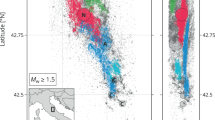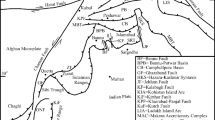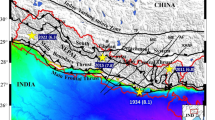Abstract
The magnitude–frequency relationship is a fundamental statistic in seismology. Customarily, the temporal variations of b values in the magnitude–frequency distribution are demonstrated via “sliding-window” approach. However, the window size is often only tuned empirically, which may cause difficulties in interpretation of b value variability. In this study, a continuous-time hidden Markov model (HMM) is applied to characterize b value variations of New Zealand shallow earthquakes over decades. HMM-based approach to the b value estimation has some appealing properties over the popular sliding-window approach. The estimation of b value is stable over a range of magnitude thresholds, which is ideal for the interpretation of b value variability. The overall b values of medium and large earthquakes across North Island and northern South Island in New Zealand vary roughly at a decade scale. It is noteworthy that periods of low b values are typically associated with the occurrences of major large earthquakes. The overall temporal variations of b values seem prevailing over many grids in space as evidenced by a comparison of spatial b values in many grids made between two periods with low or high b values, respectively. We also carry out a pre-seismic b value analysis for recent Darfield earthquake and Cook Strait swarm. it is suggested that the mainshock rupture is nucleated at the margin of or right at low b value asperities. In addition, short period of pre-seismic b value decrease is observed in both cases. The overall time-varying behavior of b values over decades is an indication of broad scale of time-varying behavior associated with subduction process, probably related to the convergence rate of the plates. The advance in the method of b value estimation will enhance our understanding of earthquake occurrence and may lead to improved risk forecasting.










Similar content being viewed by others
References
Amorèse, D., Grasso, J.-R., & Rydelek, P. A. (2010). On varying b-values with depth: Results from compputer-intensive tests for Southern California. Geophysical Journal International, 180, 347–360.
Cao, A., & Gao, S. S. (2002). Temporal variation of seismic b-values beneath northeastern Japan island arc. Geophysical Research Letters, 29(9), 1–3.
Efron, B., & Tibshirani, R. J. (1994). An introduction to the bootstrap. New York: Chapman and Hall.
Gerstenberger, M., Wiemer, S., & Giardini, D. (2001). A systematic test of the hypothesis that the b value varies with depth in California. Geophysical Research Letters, 28, 57–60.
Gerstenberger, M., & Rhoades, D. (2010). New Zealand earthquake forecast testing centre. Pure and Applied Geophysics, 167(8–9), 877–892.
Goebel, T. H. W., Schorlemmer, D., Becker, T. W., Dresen, G., & Sammis, C. G. (2013). Acoustic emissions document stress changes over many seismic cycles in stick-slip experiments. Geophysical Research Letters, 40, 20492054. doi:10.1002/grl.50507.
Harte, D., & Vere-Jones, D. (1999). Differences in coverage between the PDE and New Zealand local earthquake catalogues. New Zealand Journal of Geology and Geophysics, 42, 237–253.
Jarrard, R. D. (1986). Relations among subduction parameters. Reviews of Geophysics, 24(2), 217–284.
Kagan, Y. Y. (1999). Universality of the seismic moment-frequency relation. PAGEOPH, 155, 537–573.
Kamer, Y., & Hiemer, S. (2015). Data-driven spatial b value estimation with applications to California seismicity: To b or not to b. Journal of Geophysical Research: Solid Earth, 120, 5191–5214. doi:10.1002/2014JB011510.
Lu, S. (2016). A continuous-time HMM approach to modeling the magnitude-frequency distribution of earthquakes. Journal of Applied Statistics, 44(1), 71–88.
Lu, S., & Vere-Jones, D. (2011). Large occurrence patterns of New Zealand deep earthquakes: Characterization by use of a switching Poisson model. PAGEOPH, 168, 1567–1585.
McCaffrey, R. (1994). Dependence of earthquake size distributions on convergence rates at subduction zones. Geophysical Research Letters, 21(21), 2327–2330.
McCaffrey, R. (1997). Influences of recurrence times and fault zone temperatures on the age-rate dependence of subduction zone seismicity. Journal of Geophysical Research, 102(B10), 22839–22854.
Mignan, A. (2012). Functional shape of the earthquake frequency–magnitude distribution and completeness magnitude. Journal of Geophysical Research, 117, B08302. doi:10.1029/2012JB009347.
Mignan, A., & Chouliaras, G. (2014). Fifty years of seismic network performance in Greece (1964–2013): Spatiotemporal evolution of the completeness magnitude. Seismological Research Letters, 85, 657–667. doi:10.1785/0220130209.
Mignan, A., & Woessner, J. (2012). Estimating the magnitude of completeness for earthquake catalogues, CORSSA. doi:10.5078/corssa-00180805. Available at http://www.corssa.org.
Molnar, P. (1979). Earthquake recurrence intervals and plate tectonics. Bulletin of the Seismological Society of America, 69(1), 115–133.
Nanjo, K. Z., Hirata, N., Obara, K., & Kasahara, K. (2012). Decade-scale decrease in b value prior to the M9-class 2011 Tohoku and 2004 Sumatra quakes. Geophysical Research Letters, 39, L20304. doi:10.1029/2012GL052997.
Rhoades, D. A. (1996). Estimation of the Gutenberg–Richter relation allowing for individual earthquake magnitude uncertainties. Tectonophysics, 258, 71–83.
Roberts, W. J. J., & Ephraim, Y. (2008). An EM algorithm for ion-channel current estimation. IEEE Transactions on Signal Processing, 56(1), 26–32.
Ruff, L., & Kanamori, H. (1980). Seismicity and the subduction process. Physics of the Earth and Planetary Interiors, 23, 240–252.
Ruff, L., & Kanamori, H. (1983). Seismic coupling and uncoupling at subduction zones. Tectonophysics, 99, 99–117.
Scholz, C. H. (1968). The frequency–magnitude relation of microfracturing in rock and its relation to earthquakes. Bulletin of the Seismological Society of America, 58, 399–415.
Schorlemmer, D., Weimer, S., & Wyss, M. (2005). Variations in earthquake-size distribution across different stress regimes. Nature, 437, 539–542.
Wiemer, S., & Benoit, J. P. (1996). Mapping the b-value anomaly at 100 km depth in the Alaska and New Zealand subduciton zones. Geophysical Research Letters, 23(13), 1557–1560.
Woessner, J., & Wiemer, S. (2005). Assessing the quality of earthquake catalogues: Estimating the magnitude of completeness and its uncertainty. Bulletin of the Seismological Society of America, 95, 684–698.
Wyss, M., Pacchiani, F., Deschamps, A., & Patau, G. (2008). Mean magnitude variations of earthquakes as a function of depth: Different crustal stress distribution depending on tectonic setting. Geophysical Research Letters, 35, L01307. doi:10.1029/2007GL031057.
Zucchini, W., & MacDonald, I. L. (2009). Hidden Markov models for time series: An introduction using R. New York: Chapman and Hall.
Acknowledgements
Referees’ suggestions are acknowledged. We are grateful for the financial support by Specialized Research Fund for the Doctoral Program of Higher Education No. 105273934.
Author information
Authors and Affiliations
Corresponding author
Rights and permissions
About this article
Cite this article
Lu, S. Long-Term b Value Variations of Shallow Earthquakes in New Zealand: A HMM-Based Analysis . Pure Appl. Geophys. 174, 1629–1641 (2017). https://doi.org/10.1007/s00024-017-1482-5
Received:
Revised:
Accepted:
Published:
Issue Date:
DOI: https://doi.org/10.1007/s00024-017-1482-5




